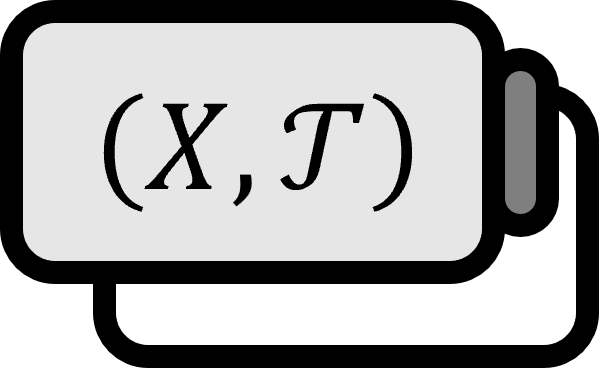Connectivity in Topology
Definitions 1
In a topological space $X$, if there exist open sets $A \ne \emptyset$, $B \ne \emptyset$ that satisfy $A \cap B = \emptyset$ and $A \cup B = X$, then $X$ is called a Disconnected space. If it is not disconnected, it is called a Connected space.
Theorems
- [1]: Connectedness is a topological property.
- [2]: Every trivial space is a connected space.
- [3]: Every discrete space is a disconnected space.
- [4]: Every singleton set is connected.
Description
The definition of being not connected is quite intuitive, and its negation, being connected, is also easily acceptable. Graph theory defines connectedness in a similar manner.
For example, if we consider the Euclidean space $( \mathbb{R} , d )$, it is a connected space as it does not satisfy the conditions for being disconnected, regardless of which open interval is considered. On the other hand, if we consider its subspace $( \mathbb{Q}, d )$, since $( \mathbb{Q} , d ) = ( \mathbb{Q} , \mathscr{P} ( \mathbb{Q} ) )$ is a discrete space, it can easily be shown to be a disconnected space.
Proofs
[1]
Let there exist a homeomorphic mapping $f : X \to Y$, and let $X$ be a connected space. To prove that $Y$ is a connected space, it is sufficient.
Assuming $Y$ is a disconnected space, then there exist open sets $A, B \subset Y$ that satisfy $$ A \cap B = \emptyset \\ A \cup B = Y $$
Since $Y$ is continuous, $f^{-1} (A)$ and $f^{-1} (B)$ are open sets in $X$. However, $$ f^{-1} (A) \cap f^{-1} (B) = f^{-1} (A \cap B) = f^{-1} ( \emptyset ) = \emptyset \\ f^{-1} (A) \cup f^{-1} (B) = f^{-1} (A \cup B) = f^{-1} ( Y ) = X $$ This is a contradiction to the assumption that $X$ is a disconnected space.
■
[2]
In the topology $\mathscr{T} = \left\{ \emptyset , X \right\}$ of the trivial space $X$, there do not exist two non-empty open sets, so $X$ is a connected space.
■
[3]
If $X$ has only one element, it is a trivial space rather than a discrete space, so we must assume that $X$ has more than one element. In the discrete space $X$, every non-empty open set $U$ such that $V = X \setminus U$ is an open set in $X$, so it is a disconnected space.
■
[4]
For $A , B \subset \left\{ x \right\}$ to satisfy $A \cap B = \emptyset$, either $A$ or $B$ must necessarily be empty, so it cannot be a disconnected space.
■
Munkres. (2000). Topology(2nd Edition): p148. ↩︎
